Did you know the charming tricolor Cavalier King Charles Spaniel has a royal history? Originating in England, this breed descended from toy Spaniels and was named after King Charles II. With their distinctive tricolor coat and affectionate nature, it’s no wonder they’ve captured the hearts of dog lovers worldwide.
The American Kennel Club (AKC) recognized this elegant breed of dog in 1995, adding to its rich history in the United Kingdom. So if you’re looking for a loyal Blenheim or tricolor Cavalier King Charles Spaniel puppy with a regal flair, look no further!
Table of Contents
- 1 Characteristics and Appearance of Tricolor Cavaliers
- 2 Unique Traits Setting Tricolors Apart from Other Cavalier King Charles Spaniels
- 3 Care and Grooming Tips for Tricolor Cavalier King Charles Spaniels
- 4 Health Concerns: Hip, Knee, Ear Disorders, and Episodic Falling in Tricolor Cavaliers
- 5 Divergence from King Charles Spaniels: Comparing Tricolors
- 6 The Enduring Appeal of Tricolor Cavalier King Charles Spaniels
- 7 Related posts:
- 8 Can Cavalier King Charles Spaniels Swim? Discover Their Love for Water!
- 9 Dapple Dachshund: Breed Facts & Care Guide
- 10 Black Pomeranian: Complete Breed Info & Pictures
- 11 From Regal to Playful: Understanding the Versatile Cavalier King Charles Spaniel Temperament
Characteristics and Appearance of Tricolor Cavaliers
Tricolor Cavalier King Charles Spaniels, a breed recognized by the American Kennel Club, are known for their stunning coat colors. As the name suggests, these dogs have a beautiful combination of black, white, and tan fur, differing from the Blenheim variety. The distribution of these colors can vary from dog to dog, but some common patterns include:
- Black body with white chest and legs
- Tan markings on the face and eyebrows
- White blaze down the center of the face
This unique coloration sets tricolor King Charles Spaniel Cavaliers apart from their Blenheim breed counterparts, showcasing the black variety in this distinctive breed.
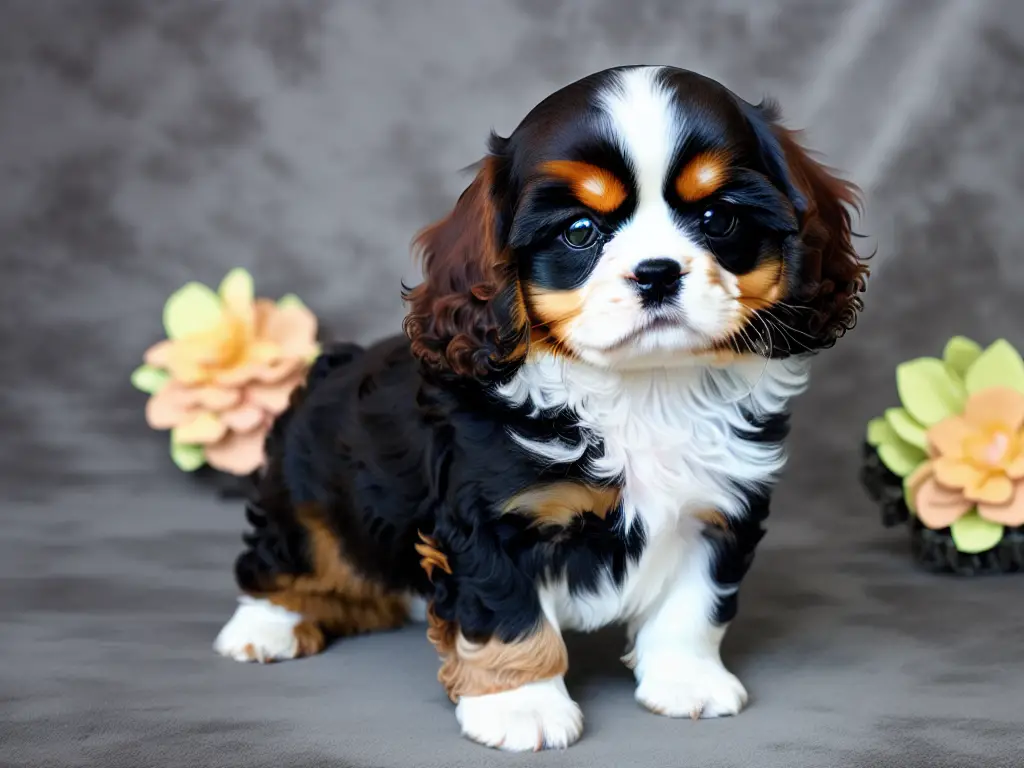
Silky, Medium-Length Fur
The fur on a tricolor Cavalier spaniel is silky to the touch and medium in length. This soft coat adds to its overall charm and appeals as a breed recognized by the kennel club. Regular grooming is essential for these dogs to keep their fur looking its best. Some tips for maintaining a healthy coat include:
- Brushing at least once a week to prevent tangles
- Using a high-quality dog shampoo for bathing
- Regularly checking for any skin issues or irritations
Feathering on Ears, Legs, and Tail
One distinctive feature of tricolor King Charles Spaniel Cavaliers, a popular breed recognized by the Kennel Club, is the feathering on their ears, legs, and tail. This longer hair gives them an elegant appearance that many people find irresistible, especially compared to their Blenheim counterparts.
Feathering can be more pronounced in some dog breeds, such as the Cavalier King Charles Spaniel, than others but generally includes scratching and other symptoms.
- Long hair on the backs of the legs
- Fringe-like hair around the ears
- Plume-like tail with longer fur along its length
Regular trimming may be necessary to keep the feathering neat for breeds like the Cavalier King Charles Spaniel, preventing scratching and maintaining their condition.
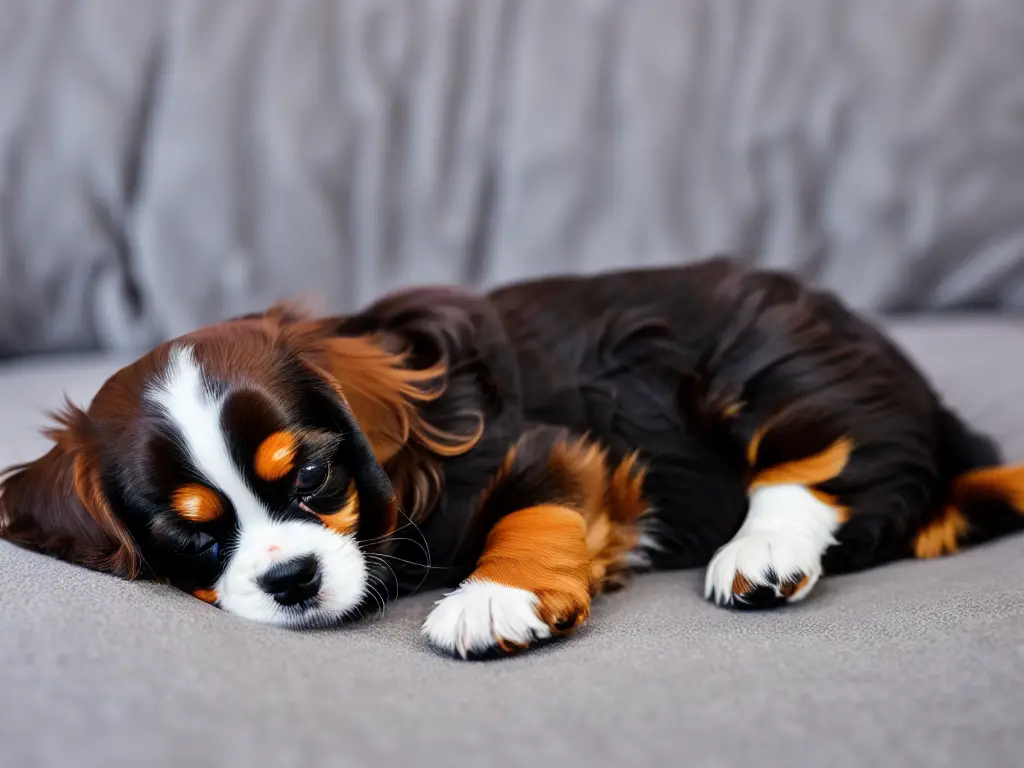
Expressive Eyes with “Puppy Dog” Look
Tricolor Cavalier King Charles Spaniels, a breed recognized by the kennel club, are renowned for their expressive eyes that give these dogs an endearing “puppy dog” look throughout their lives. These large, round eyes, also seen in the Blenheim variety, are typically dark brown.
The soulful gaze of the Cavalier King Charles Spaniel, particularly in Blenheim Cavalier and black dogs, is often considered one of the breed’s most fascinating features.
Unique Traits Setting Tricolors Apart from Other Cavalier King Charles Spaniels
Tricolor Cavalier King Charles Spaniels, a popular breed of dogs, have a unique appearance that sets them apart from their fellow Cavaliers, including the Blenheim variety. One of the most noticeable features is their distinctive “mask” facial markings. These markings consist of black patches around the eyes and nose, giving them a charming appearance that’s hard to resist and often leads to owners lovingly scratching their faces.
Rich Tan Coloration Around Eyebrows and Cheeks
Another characteristic that makes tricolor Cavalier spaniels stand out is the rich tan coloration around their eyebrows and cheeks. This beautiful contrast against the black mask adds depth and dimension to their faces, making this breed of dogs even more adorable than their Blenheim counterparts. Some common areas where you can find these tan markings include:
- Above the eyes (eyebrows)
- On the cheeks
- Inside the ears
- Underneath the tail
- On both sides of their chest
Rarer Than Other Color Variations
Tricolor King Charles Spaniel Cavaliers are rarer than other color variations in the breed, adding to their appeal for many dog lovers. While Blenheim (chestnut and white) Cavaliers are standard, finding a tricolor, which includes black, can be more challenging. However, this rarity doesn’t affect these dogs’ personality or temperament – they’re still as loving and friendly as any other Cavalier!
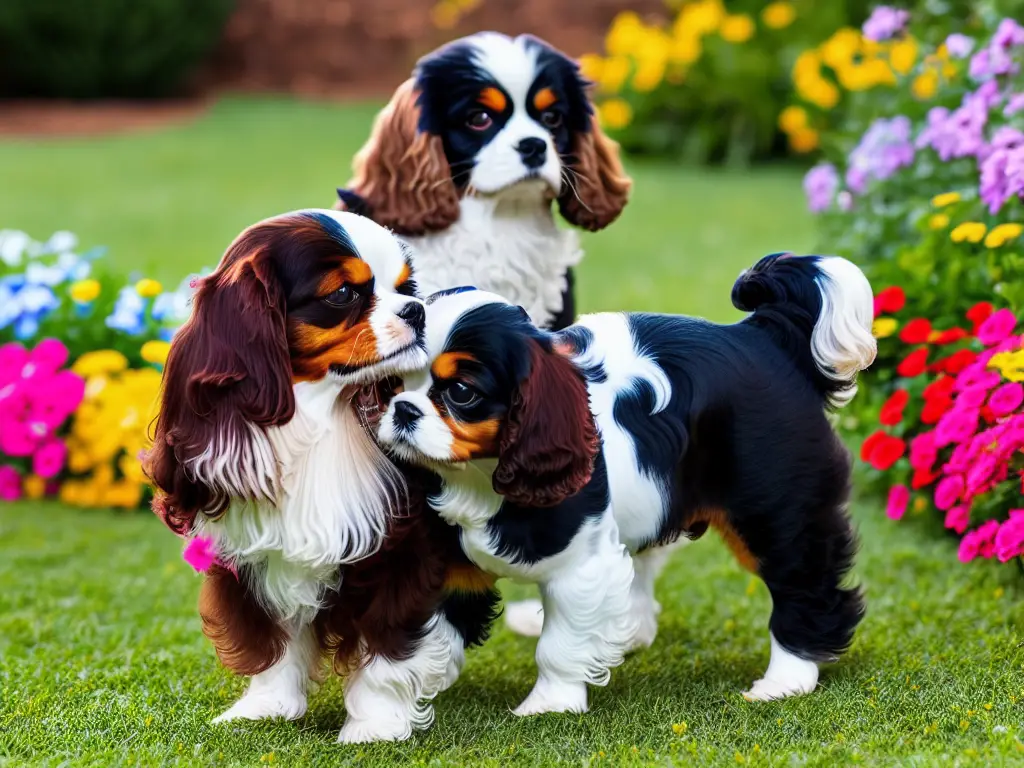
Same Temperament as Other Cavaliers
Despite their unique appearance, tricolor and Blenheim Cavalier King Charles Spaniels share the same sweet temperament as other color variations of this breed, including the black and butlertri variations. They’re known to be affectionate, friendly, and great with families – including children! Some typical traits you’ll find in these dogs include:
- Gentle nature
- Playfulness
- Eagerness to please
- Love for cuddles and attention
Care and Grooming Tips for Tricolor Cavalier King Charles Spaniels
Tricolor Cavalier King Charles Spaniels, a beautiful breed of dogs, have stunning, long coats that require regular maintenance. To keep their fur, which includes Blenheim and black colors, looking its best:
- Brush your cavalier king Charles spaniel dog at least 2-3 times a week, regardless of breed or butler trio.
- Use a slicker brush or comb to detangle knots.
- Start from the head and work your way down to the breed’s tail, specific dogs like the Blenheim Cavalier King Charles Spaniel.
- Be gentle when brushing dogs, especially the Cavalier King Charles Spaniel breed, as their Blenheim skin can be sensitive.
This routine will help prevent matting and keep your furry friend looking fabulous, especially dogs like the spaniel breed or butler trio.
Trim Hair Between Paw Pads
Long hair between the paw pads can cause discomfort and even lead to injuries in dogs, especially in breeds like the Cavalier King Charles Spaniel. To avoid this for your butlertri:
- Place your dog on a stable surface
- Use a pair of grooming scissors or clippers specifically designed for pets, such as dogs and Cavalier King Charles Spaniels.
- Carefully trim the hair between each pad of your Cavalier King Charles Spaniel dog, being cautious not to cut too close to the skin.
- Ensure all excess hair is removed from your dogs, especially Cavalier King Charles Spaniels, for a clean, comfortable finish.
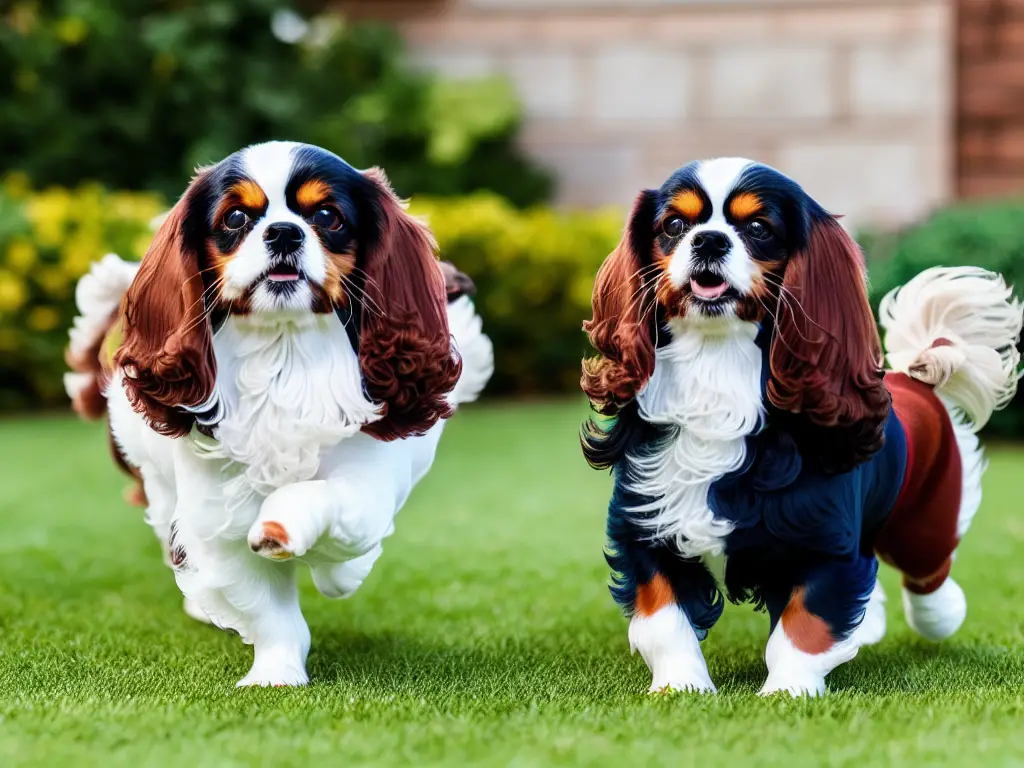
Keeping their paws well-groomed helps your pup stay safe and comfy during walks.
Clean Ears to Avoid Infections
Cavalier King Charles Spaniel dogs are prone to ear infections due to their long, floppy ears. To minimize this risk:
- Check your Cavalier King Charles Spaniel dog’s ears weekly for signs of redness, swelling, or discharge
- Use a vet-recommended ear-cleaning solution on a cotton ball or gauze pad for dogs, especially Cavalier King Charles Spaniels.
- Gently wipe the outer part of the ear canal for dogs, especially Cavalier King Charles Spaniels (never insert anything deep into the canal)
- Dry any remaining moisture on your Cavalier King Charles Spaniel dog with a clean cloth or paper towel.
Remember, healthy ears are vital in maintaining overall health for your tricolor Cavalier King Charles Spaniel buddy, as dogs need proper care!
Bathe Every Few Weeks or As Needed
Bathing is essential for keeping your spaniel dog’s coat clean and free from dirt and debris.
Health Concerns: Hip, Knee, Ear Disorders, and Episodic Falling in Tricolor Cavaliers
Tricolor Cavalier King Charles Spaniels, a breed of dogs, are prone to developing mitral valve disease (MVD), a heart disorder that affects blood flow. This condition can lead to:
- Heart murmurs
- Congestive heart failure
- Shortness of breath
- Fatigue
Regular vet check-ups and early detection can help manage MVD and improve your spaniel dog’s quality of life.
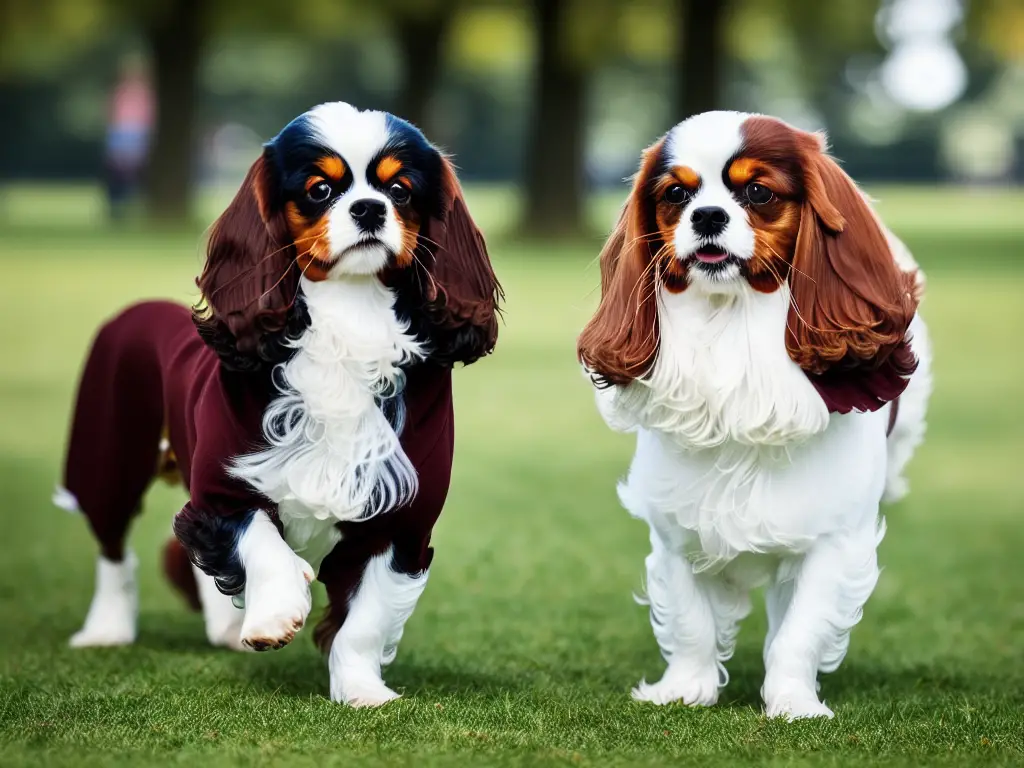
Patellar Luxation Prevalence
These adorable spaniel pups are also susceptible to patellar luxation, a knee issue where the kneecap dislocates from its normal position in dogs. Signs of this problem include:
- Limping or skipping steps
- Difficulty jumping or climbing stairs
- Sudden pain in the affected leg
Surgery may be necessary in severe cases to correct the issue in dogs, especially Spaniels.
Susceptibility to Ear Infections
Their long ears make tricolor Cavalier spaniels more prone to ear infections than other dogs. To prevent these painful conditions, it’s essential to:
- Regularly clean your spaniel dogs’ ears with a gentle solution recommended by your vet
- Keep their ears dry after swimming or bathing
- Check for signs of infection in your spaniel dog, like redness, swelling, and foul odor
If you notice any symptoms of an ear infection in your dog, especially Spaniels, consult your veterinarian for appropriate treatment.
Genetic Predisposition to Episodic Falling Syndrome
Episodic falling syndrome (EFS) is a rare genetic disorder that affects some tricolor Cavalier spaniel dogs. This condition causes muscle stiffness and collapses during episodes triggered by excitement or exercise. Symptoms include:
- Temporary paralysis
- Stiffness in legs or entire body
- Difficulty moving during an episode
Although there’s no cure for EFS in Spaniels, managing triggers can help reduce the frequency and severity of episodes.
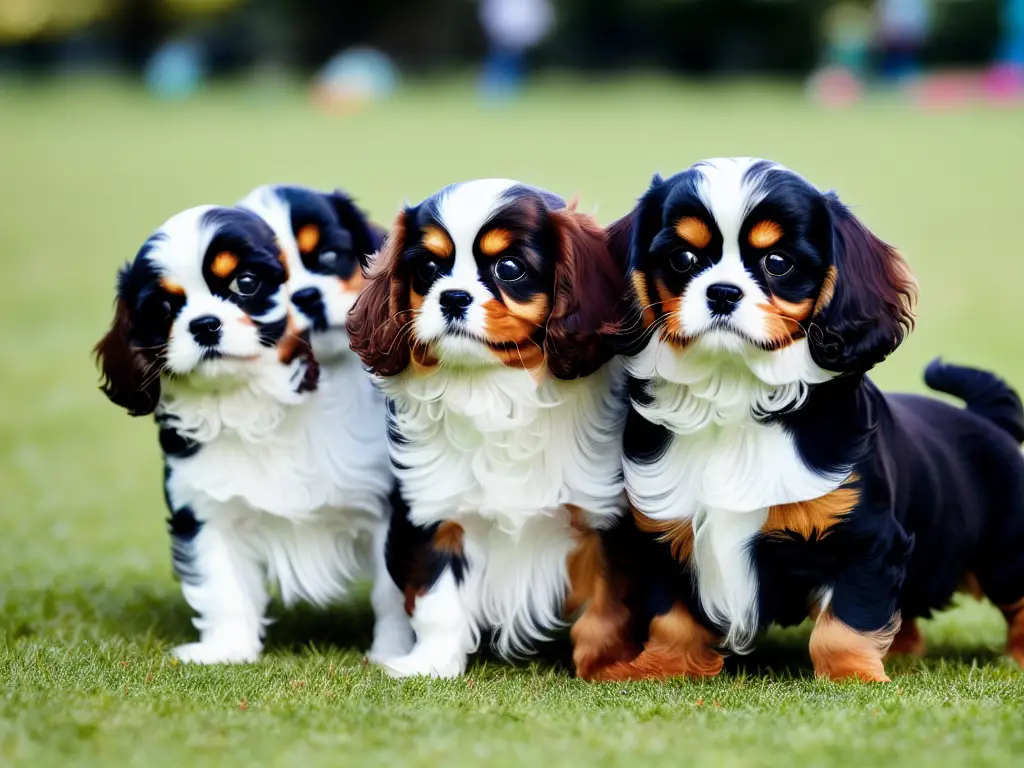
Divergence from King Charles Spaniels: Comparing Tricolors
Tricolor Cavalier King Charles Spaniels have a notably longer muzzle compared to their close relatives, King Charles Spaniel. This difference in facial structure is not just a minor variation but has practical implications as well:
- Improved breathing: A longer muzzle, like a spaniel, allows for better airflow and less risk of respiratory issues.
- Reduced dental issues: With more space in their mouths, tricolor Cavalier spaniels are less prone to overcrowding and other dental problems.
Larger Size
Another distinct feature of tricolor Cavalier King Charles Spaniels is their larger size. While still considered a small breed, they tend to be slightly more significant than the standard King Charles Spaniel. Some key differences include:
- Height: Tricolor spaniels typically stand 12-13 inches tall at the shoulder, while their relatives average around 10-11 inches.
- Weight: Tricolor Cavaliers usually weigh between 13 and 18 pounds, whereas the King Charles Spaniel ranges from 8 to 14 pounds.
Different Breed Standards
Kennel clubs worldwide have different breed standards for tricolor Cavalier King Charles Spaniels compared to their close relatives. These standards dictate various aspects of appearance and temperament that breeders aim for when producing show-quality dogs. Some examples of differing standards include:
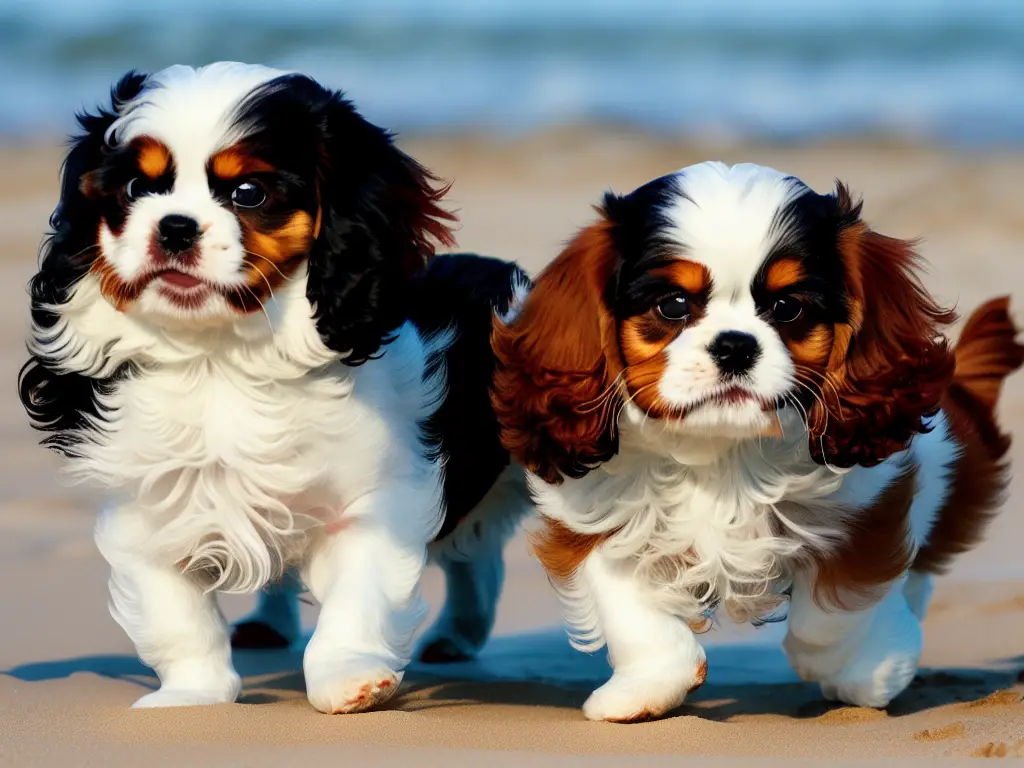
- Coat color: Tricolor Cavalier spaniels must have a predominantly white coat with black and tan markings, while other spaniel varieties can come in solid or mixed colors.
- Ear placement: The ears on tricolors should be set high on the head, whereas those on regular King Charles Spaniels are placed lower.
Less Domed Skull Shape
The skull shape of tricolor Cavalier King Charles Spaniels is another area where they diverge from their close relatives. Instead of having a domed skull like the typical King Charles Spaniel, tricolors have a flatter head.
The Enduring Appeal of Tricolor Cavalier King Charles Spaniels
In conclusion, tricolor Cavaliers are a unique and charming breed with a distinct appearance, setting them apart from other Cavalier King Charles Spaniels. Their care and grooming needs are manageable, but awareness of potential health concerns like hip, knee, and ear disorders and episodic falling is essential.
Despite their divergence from King Charles Spaniels, tricolors have won the hearts of many dog lovers due to their lovable temperament and striking looks. So if you’re considering welcoming one into your family, make sure to do your research and provide the best possible care for these adorable pups!
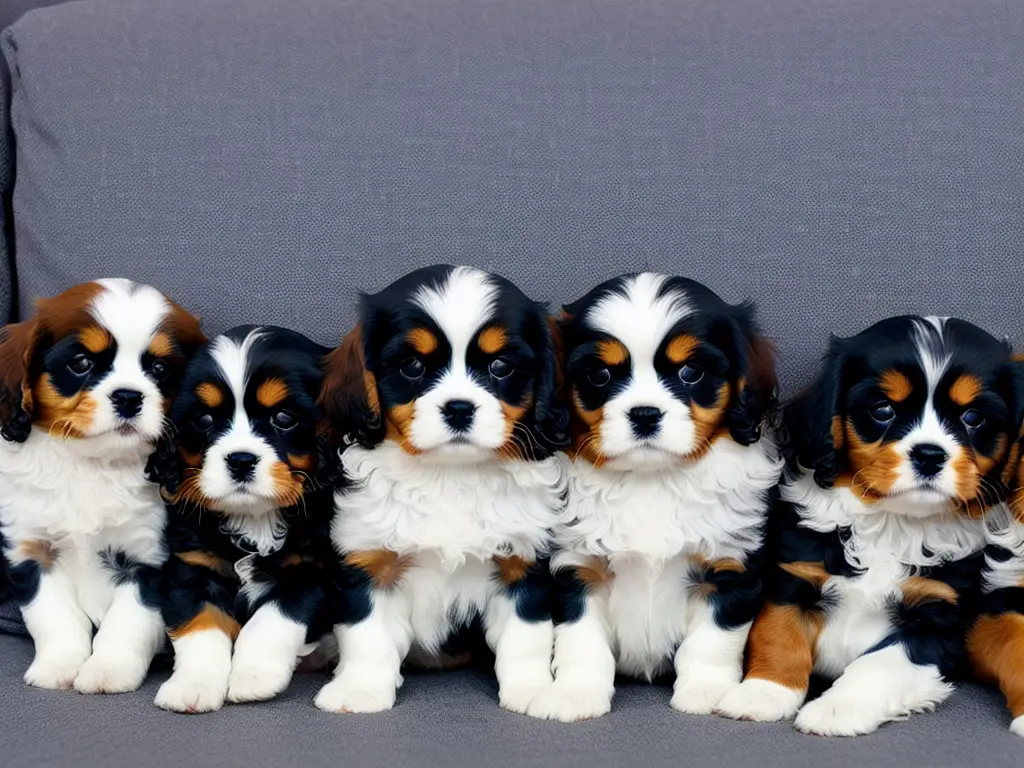
Now that you’ve learned all about tricolor Cavaliers, why not take the next step? Start looking for reputable spaniel breeders or rescue organizations in your area and bring home an adorable new companion.
How often should I groom my tricolor Cavalier?
Tricolor Cavalier Spaniels require regular grooming to maintain their beautiful coat. Brushing at least twice a week is recommended to prevent matting and tangles.
Are tricolor Cavaliers good with children?
Yes! Tricolor Cavaliers are known for their gentle nature and affectionate personality. They generally get along well with children when appropriately introduced.
What kind of exercise does a tricolor Cavalier need?
Tricolor Cavaliers enjoy daily walks or play sessions. Moderate exercise helps keep them healthy both physically and mentally.
How can I find a reputable tricolor Cavalier King Charles Spaniels breeder?
To find a responsible breeder, ask for recommendations from veterinarians or local breed clubs. Always visit the breeder’s facility in person to ensure they follow ethical breeding practices.
How can I prevent health issues in my tricolor Cavalier?
Regular veterinary check-ups, proper diet, exercise, and grooming are crucial for maintaining your tricolor Cavalier’s overall health. Be proactive in addressing any concerns or symptoms that may arise.